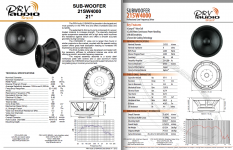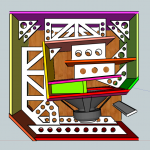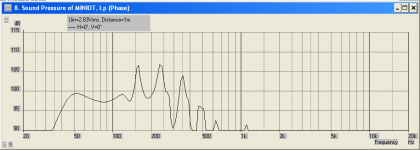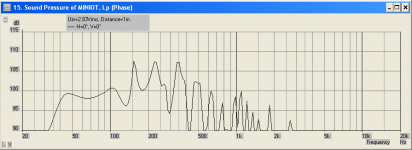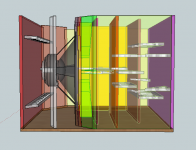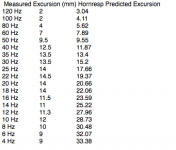When I calculate out BL from the fs, Qes, vas, and sd I don't get the high values stated in the spec. I get numbers a little more normal. When I saw the 21, I thought that might be interesting. But then I started playing around with it in Hornresp, and found that Something Isn't Right Here.
I also mentioned this to the above stated distributor at the end of January. This is what PRV had to say:
"I took a quick look and he is absolutely correct. Our documents here show 40.83 BL on the 21SW4000. That is an error on the datasheet and we will correct it right now.
Attached is a corrected datasheet. We have updated the datasheet on the website as well. Pass along our thanks for catching this."
Maybe I'll send a request for the 18SW2200
Cheers,
Justin
Attachments
When I calculate out BL from the fs, Qes, vas, and sd I don't get the high values stated in the spec. I get numbers a little more normal. When I saw the 21, I thought that might be interesting. But then I started playing around with it in Hornresp, and found that Something Isn't Right Here.
I also mentioned this to the above stated distributor at the end of January. This is what PRV had to say:
"I took a quick look and he is absolutely correct. Our documents here show 40.83 BL on the 21SW4000. That is an error on the datasheet and we will correct it right now.
Attached is a corrected datasheet. We have updated the datasheet on the website as well. Pass along our thanks for catching this."
PRV
It's still showing 40.83 BL in the Att. & as a Direct DL from PRV's www ?
Also the specs have changed from the 2013 version, without any explanation
Our documents here show 40.83 BL on the 21SW4000. That is an error on the datasheet and we will correct it right now.
It's still showing 40.83 BL in the Att. & as a Direct DL from PRV's www ?
Also the specs have changed from the 2013 version, without any explanation
It's still showing 40.83 BL in the Att. & as a Direct DL from PRV's www ?
Correct. That is the updated version. It used to state a 20-something BL.
Cheers,
Justin
@ CRESCENDO
Hi, thanx for the clarification
It's the way the email was worded
Made it sound like the 40.83 BL was the error !
Well the 2k14 version has a LOT more changes made to it from the 2k13 one. I hate it when do that They should have different model #'s when they change the specs.
They should have different model #'s when they change the specs.
Hi, thanx for the clarification
It's the way the email was worded
Our documents here show 40.83 BL on the 21SW4000. That is an error on the datasheet and we will correct it right now.
Made it sound like the 40.83 BL was the error !
Well the 2k14 version has a LOT more changes made to it from the 2k13 one. I hate it when do that
Made it sound like the 40.83 BL was the error !
Well the 2k14 version has a LOT more changes made to it from the 2k13 one. I hate it when do thatThey should have different model #'s when they change the specs.
Dunno, but 40.83 N/A BL is correct based on its other specs.
Don't have/couldn't find any other specs in a quick search, but I agree that manufacturers should at least add a revision letter to any change that requires a significantly different alignment and/or changes its power handling capability and/or mounting requirements.
GM
@ CRESCENDO
I've uploaded the PRV 21SW4000 Datasheet from 2k13. If you compare it to the 2k14 version, you'll see there are a LOT more differences between them, than only making allowance for the BL changes.
@ GM
Yes, vendors need to get a grip & realise that they MUST revise their model #'s when making even ONE change !
I've uploaded the PRV 21SW4000 Datasheet from 2k13. If you compare it to the 2k14 version, you'll see there are a LOT more differences between them, than only making allowance for the BL changes.
@ GM
Yes, vendors need to get a grip & realise that they MUST revise their model #'s when making even ONE change !
Attachments
Sounds like a real misprint, perhaps it should read 30.8 BL.So it the consensus that 40.8 BL is real?
The 2012 v4 21SW4000 spec sheet shows DCR at 5.2 ohm, BL 27.
The 2014 revision shows DCR at 4.4 ohm, BL 40.83, and claims MMS went from 315G to 520.9 G!
Since when does a 4.4 ohm driver qualify as 8 ohm nominal?
As a comparison, the B&C 21SW152-8 has DCR of 5.4 ohm, BL 30.13, MMS 342.2G, the 21SW152-4 has DCR of 3.4 ohm, BL 32.5, MMS 460G.
Attachments
The spider riser rings look to be laser cut MDF, hopefully they are cardboard tube or anything but MDF. 
An externally hosted image should be here but it was not working when we last tested it.
Hi NEO Dan,The spider riser rings look to be laser cut MDF, hopefully they are cardboard tube or anything but MDF.
Looks more like cheap steel to me...
Nevertheless, their drawings (6mm higher) are also not in line with their specs…
Fwiw, it also suggests a top-plate of 14,9mm
Oh... and where is that riser ring?

Well, heres the cab post fold that I originally tried to make for the dayton 15. It was inspired by JWMBRO'S original attempt (with incorrect specs). Internal width is 19 inches, final box size is 25x25x19. The spec change resulted in a slightly larger box, and loss of extension and sensitivity (with the dayton), vs jwmbro's original posted design. It also will only take 70v vs the 80v of the original, so max output is reduced as well.
Primary concern her was compact size (while still realizing small gains over bass reflex enclosures.).
The horn resp sim is a little rough because a couple small liberties had to be taken with the fold. The design post fold has been checked out with akabak by a gracious member here, who i'm sure will chime in if he wants. Pic 2 is the daytons 2.83v response
I've found that both the 15tbw100, and the faital pro hp1030 are good replacement drivers, the faital represented by pic 3, both will take 80v before exceeding xmax, AND offer better extension and better upper passband response (up to 120).
It takes 4 faital 1030hp in bassreflex boxes at xmax to match 3 of the tapped horn design @ xmax (both hit xmax at 80v)
Primary concern her was compact size (while still realizing small gains over bass reflex enclosures.).
The horn resp sim is a little rough because a couple small liberties had to be taken with the fold. The design post fold has been checked out with akabak by a gracious member here, who i'm sure will chime in if he wants. Pic 2 is the daytons 2.83v response
I've found that both the 15tbw100, and the faital pro hp1030 are good replacement drivers, the faital represented by pic 3, both will take 80v before exceeding xmax, AND offer better extension and better upper passband response (up to 120).
It takes 4 faital 1030hp in bassreflex boxes at xmax to match 3 of the tapped horn design @ xmax (both hit xmax at 80v)
Attachments
Last edited:
Well, heres the cab post fold that I originally tried to make for the dayton 15. It was inspired by JWMBRO'S original attempt (with incorrect specs) . . . .
Hey Sine143, NICE!!!!
Great SketchUp drawing. Can you explain what is going on there with the light green piece that is at an angle (S1)? I haven't seen that done before - what are you trying to accomplish there?
I was playing around with a front loaded horn idea for the Dayton Pro 385-S this afternoon. It looks fairly interesting at the moment - but then I probably don't know what I am doing.
Thanks for posting your design - I hope you build it and post your results soon.
That was a trick taken from the Othorn plans (whose fold greatly inspired this anyways).
basically, its a way to reduce CSA (Cross sectional area) at S1. Restricting the S1 CSA had the effect of increasing excursion control, and extending the upper passband response from 100 to around 120, as well as giving a bit more output between 40 and 50 (at expense of 1 hz extension). In my opinion, it makes sense to do it this way because it braces the baffle panel, and offers a more "even load" on the cone vs doing it the way one would assume you would flare l12 if s1 was around 1 or whatever.
heres a pic from the side... might make it more clear.
I might be going overboard with the bracing, and some slight modifications need to be made still to allow for the right angle handle i'm going to use in the back left corner and the dish handle I'm going to put on the top. I likely WONT be using the dayton for the first build (Leaning towards Faital ATM)
and dont prep the wake for any poor hole saws just yet... I'm thinking CNC for the braces
basically, its a way to reduce CSA (Cross sectional area) at S1. Restricting the S1 CSA had the effect of increasing excursion control, and extending the upper passband response from 100 to around 120, as well as giving a bit more output between 40 and 50 (at expense of 1 hz extension). In my opinion, it makes sense to do it this way because it braces the baffle panel, and offers a more "even load" on the cone vs doing it the way one would assume you would flare l12 if s1 was around 1 or whatever.
heres a pic from the side... might make it more clear.
I might be going overboard with the bracing, and some slight modifications need to be made still to allow for the right angle handle i'm going to use in the back left corner and the dish handle I'm going to put on the top. I likely WONT be using the dayton for the first build (Leaning towards Faital ATM)
and dont prep the wake for any poor hole saws just yet... I'm thinking CNC for the braces
Attachments
Last edited:
Dayton PA385S-8 Tests 3/31/14 and 4/1/14
Run in:
16 Hz 11.92V 9mm peak to peak
16 Hz 18V 11mm peak to peak
16 Hz 32.24V 24mm peak to peak, forward excursion looked like some hesitancy (more 2mm blur)
16 Hz 30.3V 20mm peak to peak
After 70 minutes, the drivers had 21mm peak to peak movement. The drivers were only a few degrees above ambient temperature (around 68 F), the amp perhaps 10 degrees above ambient. Voltage was increased to 42V, resulting in 26mm p to p, with no more forward blur.
The Dayton PA385S-8 driver tested below reads 5.5 ohms DCR, one other driver measures the same, two measure 5.4 ohms, published Re specification is 5.84 ohms., Xmax 10mm.
Open air sine wave excursion tests were conducted at 54.6 volts, using a dot on the cone and persistence of vision to measure peak to peak excursion the results divided by 2 for one way excursion.
Additional sweeps were conducted at 76 volts, maximum excursion was around 17.5mm (one way), Hornresp predicts 26.97mm at 22 Hz and 46.46mm at 4 Hz.
Even at 76 volts the PA385S-8 driver had no "clacking" sounds, and vent noise was quite low, so reverse mounting should be no problem. The magnet structure had hardly any increase in heat after testing, though a slight rise could be felt around the dust cap. As in the lower power tests, maximum excursion occurred around 22 Hz, but backing off power a bit actually increased excursion below 22 Hz.
The impedance of the open air speaker is quite high through the test range, so the lack of heat is not indicative of what will happen when put in to a cabinet, but looks promising.
Some additional observations regarding the tests in post #4298 :
http://www.diyaudio.com/forums/subwoofers/119854-hornresp-430.html
Art
Run in:
16 Hz 11.92V 9mm peak to peak
16 Hz 18V 11mm peak to peak
16 Hz 32.24V 24mm peak to peak, forward excursion looked like some hesitancy (more 2mm blur)
16 Hz 30.3V 20mm peak to peak
After 70 minutes, the drivers had 21mm peak to peak movement. The drivers were only a few degrees above ambient temperature (around 68 F), the amp perhaps 10 degrees above ambient. Voltage was increased to 42V, resulting in 26mm p to p, with no more forward blur.
The Dayton PA385S-8 driver tested below reads 5.5 ohms DCR, one other driver measures the same, two measure 5.4 ohms, published Re specification is 5.84 ohms., Xmax 10mm.
Open air sine wave excursion tests were conducted at 54.6 volts, using a dot on the cone and persistence of vision to measure peak to peak excursion the results divided by 2 for one way excursion.
Additional sweeps were conducted at 76 volts, maximum excursion was around 17.5mm (one way), Hornresp predicts 26.97mm at 22 Hz and 46.46mm at 4 Hz.
Even at 76 volts the PA385S-8 driver had no "clacking" sounds, and vent noise was quite low, so reverse mounting should be no problem. The magnet structure had hardly any increase in heat after testing, though a slight rise could be felt around the dust cap. As in the lower power tests, maximum excursion occurred around 22 Hz, but backing off power a bit actually increased excursion below 22 Hz.
The impedance of the open air speaker is quite high through the test range, so the lack of heat is not indicative of what will happen when put in to a cabinet, but looks promising.
Some additional observations regarding the tests in post #4298 :
http://www.diyaudio.com/forums/subwoofers/119854-hornresp-430.html
Art
Attachments
Last edited:
Dayton PA385S-8 Tests 3/31/14 and 4/1/14
Wow, very nice review Art. Thanks. How about dropping one in a Keystone and testing it!
Last weekend I was cleaning out my shed and found an old pair of really junky PA subwoofer cabs someone had given me long ago (after they blew the drivers out). I had forgotten I had them.
These cabs were so old and cheap that they actually seemed to be built out of particle board. They had a little over 4 cubic feet interior space, so I modified the slot port to drop the tuning down to a little under 40 Hz. I had done some sims of a cab about that size and it looked pretty reasonable. I hooked up the pair to an amp with a 60 volt limit and a 35 Hz high-pass and let them blast. I was quite impressed with what I heard. They sure looked like shite in those cabs with their moldy, torn-up rat fur, but they definitely rocked. Very tight tone with no funkiness or flappiness.
- Status
- This old topic is closed. If you want to reopen this topic, contact a moderator using the "Report Post" button.
- Home
- Loudspeakers
- Subwoofers
- Dayton Audio's New 15" & 18" PA Drivers - B&C Copies?
